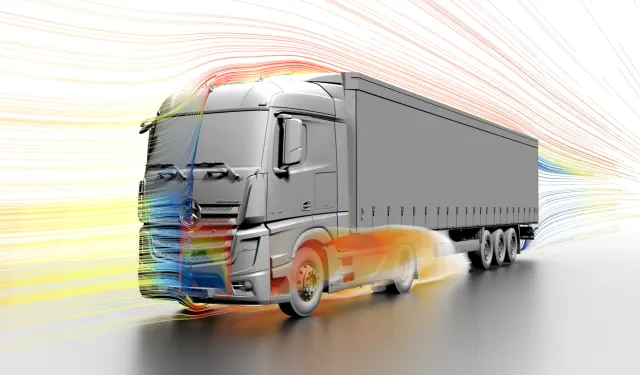The multi-physics CFD software will be one of the main CAE development tools for optimized aerodynamics and thermal management for the next generation of CO2-neutral vehicles.Daimler, the world leader in heavy trucks, has made a major investment in simulation and analysis (S&A) with Siemens’ Simcenter STAR-CCM+ software.
This solution is part of the latter’s PLM portfolio, Xcelerator, and the multi-physics CFD software will be one of the main CAE development tools for optimized aerodynamics and thermal management for the next generation of CO2-neutral vehicles.
Daimler Truck will use the Simcenter solution for calculations of fluid dynamics (CFD), improving aerodynamic performance, and to explore and optimize innovative propulsion and energy systems in e-Mobility, including battery cooling and hydrogen technology. The software will also help support legacy combustion engine and exhaust system designs and associated CO2 reduction.
The overall goal is to transform the current approach to CAE work and create an environment with digital twins as a basis for multiphysical simulation processes; a major step forward.
“Digitization is crucial for sustainable industrial innovation in the transport sector, and by providing insight into the real performance of products, Simcenter STAR-CCM+ can accelerate innovation for a better tomorrow,” said Edwin Severijn, senior VP and head of EMEA within Siemens Digital Industries Software, in a release.
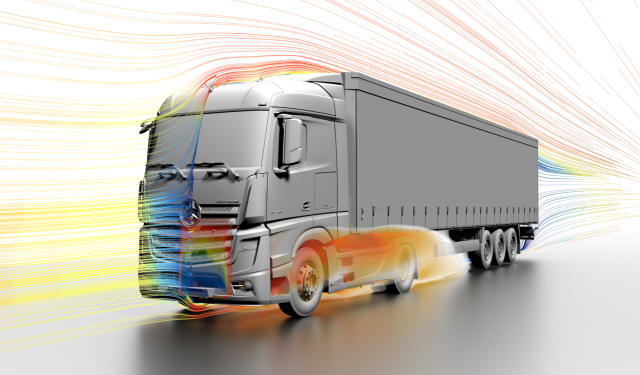
Why is CFD an Interesting Option in Truck Product Realization? One reason is that aerodynamics plays a significant role in the performance of heavy trucks, in terms of both electrical and fossil fuel driven solutions. For example, great aerodynamic design helps augment the drag. Drag reduction can greatly decrease the specific fuel consumption of the vehicle, thereby reducing the carbon footprint and saving fuel cost in the bargain. But reduction of energy consumption is also productive for electrical vehicles. This is where CFD, in the case of Daimler Truck and its use of Simcenter STAR-CCM+ software, can play a significant role in helping developers to conduct airflow simulation around the vehicle, computing the regions of high pressure, wind velocity and wake regions encompassing the vehicle under study.
Building a Digital Twin Environment
Daimler Truck became a separate legal entity December 10 th , 2021, publicly traded on the Frankfurt Stock Exchange, after its recent spin-off from the Daimler AG group. Currently, Daimler Truck is the world’s largest truck and bus manufacturer with industry-leading positions in Europe, North America and Asia, but with tough competition against Swedish Volvo Group. Moreover, the German heavy truck leader has more than 35 major facilities and 100,000 employees around the world.
Daimler Truck unites seven brands under one roof: Freightliner, Western Star, Thomas Built Buses, Mercedes-Benz, Setra, BharatBenz and FUSO.
Undoubtedly this strong global position lends significance to the choice to build a simulation and analysis environment based on digital twins using Simcenter STAR-CCM+.
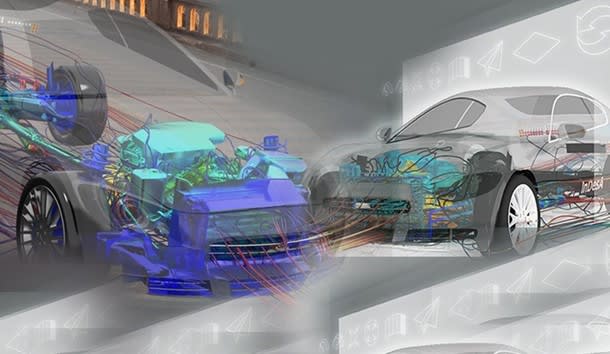
The single integrated user interface, Simcenter STAR-CCM+
Phased Out CATIA to the Benefit of NX CAD
The entire Daimler AG group, including the Mercedes-Benz division, took a major step towards the environment it has today during the years around 2015. This is when Daimler decided to phase out Dassault Systèmes’ CAD program CATIA V5, and switch to a more refined product development environment based on Siemens’ flagship product within CAD, NX. Daimler group already had Siemens Teamcenter as product data backbone for both the car and the truck and bus division, which as mentioned above, is now its own listed company under the name Daimler Truck.
The fact that Daimler Truck is now moving forward and expanding its Siemens environment is in part an indication that what they have works well, and partly that the technological practice and vision Siemens has demonstrated for Daimler is at a level capable of covering both current and future needs within e-Mobility. Incidentally, this is an assessment made by several prominent automotive companies that are users of Simcenter STAR-CCM+, including Volvo Group, Volkswagen-owned SCANIA, Volvo Cars, Polestar and Jaguar Land Rover.
Another contextually interesting fact is that S&A solutions are always significantly more expensive to invest in than, for example, CAD seats. While a company with a larger CAD user base can get discounts up to 50 percent because they are a major customer on the CAD side, there are few or marginal price reductions offered on the much more expensive CAE software licenses.
In its press material, Siemens does not reveal any specific numbers of seats or order value. However, the fact that they issued a press release about the deal is an indication that we are talking about a significant investment. The cost for an S&A license can become up to 3 to 5 times higher than a “normal” high-end CAD license, depending on specific content configuration.

A Great Product To Have In The Portfolio. When Siemens bought CD-adapco in 2016, the head of Simulation and Testing, Jan Leuridan, declared that the solution would become part of the then-emerging Simcenter portfolio. Later Leuridan said that Simcenter will do for simulation data what Siemens Teamcenter does for design and engineering data. “Simcenter will manage STAR-CCM+ data with complete lifecycle traceability, from project requirements to product design, to simulation, to results,” he said. The lead product of CD-adapco was STAR-CCM+ and it was easy to see why Siemens wanted it. The solution was already used by 14 of the 15 largest automotive companies, by all top 10 suppliers in aerospace and by nine of the 10 largest manufacturers in the energy and marine sectors. Siemens invested $970 million in this deal, which also included the HEEDS line of multidisciplinary design exploration and optimization tools.
Note that Simcenter STAR-CCM+ was one of the solutions that Siemens acquired when they bought CD-adapco in 2016 for $970 million. The purchase included software solutions that cover a wide range of technical disciplines, including fluid dynamics (CFD), solid mechanics (CSM), heat transfer, particle dynamics, reactant flow, electrochemistry, acoustics and rheology. There is no doubt that this is an attractive package of content. This was confirmed by the bidding on CD-adapco that preceded the purchase, which Dassault Systèmes was particularly involved in.
We should also add that in addition to software, today’s deal means that Siemens and Daimler Truck will collaborate in the training of young engineers to create high-level simulation specialists who will help ensure that Daimler Truck retains its market leadership.
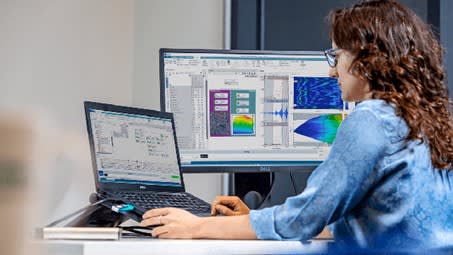
A Fast-Growing Market. Analyst Gartner claimed in an earlier survey that half of all large industrial companies would use digital twins by 2021 to 2022. The expected growth rate is correspondingly high. In fact, market research conducted by analysts at Grand View Research predicts that the digital twin market will reach $26 billion by 2025.
With The Digital Twin from Start to Goal
Having an environment built around Siemens’ digital twin concept is one of the main points in today’s announcement. In general, the concept of a digital twin has had a major impact on the market. The analyst Gartner claimed in an earlier survey that half of all large industrial companies would use digital twins by 2021 to 2022. The expected growth rate is correspondingly high. In fact, market research conducted by analysts at Grand View Research predicts that the digital twin market will reach $26 billion by 2025, at an annual growth rate of about 38 percent.
The idea of establishing digital twins is not new to Siemens, and it has developed sharp solutions around this concept with its own “organic” development work and a series of purchases over the years. Through digital twins across the entire organization, the goal is a situation where companies can handle and control everything that has to do with the digital 3D model’s product life cycle—and, of course, the related physical product—from start to finish. This includes everything from product feasibility studies, product development and manufacturing, to things such as preventive maintenance and production growth strategies on the aftermarket side.
It’s a deep move, but Siemens has taken the idea very seriously and is now quickly developing related solutions that build on these holistic concepts. It is a long journey, and while they are not yet at the end, they have come a long way. From a holistic perspective, they have perhaps come furthest of all—particularly when it comes to the interconnection of product development and manufacturing automation.
A Cornerstone in The Industry 4.0 Concept
The digital twin is a cornerstone of Industry 4.0, and it must be able to take in all the information that is needed in all the product’s life phases, simulation and analysis results included. Ideally, not only should a digital twin be able to tell itself how it should be manufactured and what resources are required, but it should also be able to tell the end user how, where and when maintenance measures are needed.
In order for the digital twin arrangement to be truly feasible, it presupposes that there are also digital copies (twins) of everything else that surrounds and is linked to the development of a digitally developed product. While a digital twin can be valuable for simulation and calculation in the product development phase, in the manufacturing phase additional values come into play—for example, based on the fact that the twin in manufacturing sends and constantly updates data to the machine that processes, positions and adjusts a substance that should become a specific physical model.
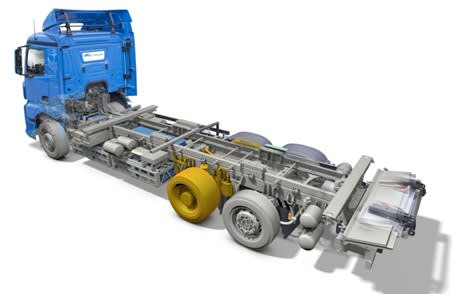
Preparing For a Battery Future. Battery-electric trucks are very well suited for urban use in waste management due to the comparatively short and plannable daily routes of up to 100 kilometers, with a high proportion of stop-and-go in inner-city traffic. With an anticipatory driving style, electrical energy can be recovered during braking to charge the battery, which further improves range and efficiency. In the picture: The eEconic model, first offered in the configuration 6×2/N NLA. In the future, Daimler Truck will drive the global production of battery-electric and hydrogen-based drive systems in a production and technology network for electric drive components and battery systems, together with the sister plant in Detroit. Several major investments are to accompany the realignment. On the production side the Gaggenau plant, which specializes in heavy-duty commercial vehicle transmissions, will be turned into a competence center for electric drive components, as well as the assembly of hydrogen-based fuel cell drive components. The Kassel plant is to be expanded in its current focus on commercial vehicle axles and will become a competence centre for electric drive systems.
A Proactive Step by Daimler Truck
It is clear with today’s announcement that Daimler Truck’s investment in building a digital twin environment around its simulation and analysis work is taking a step in a direction with strong connections to what the future will look like: digital twins that are increasingly accepted in the development of products, factory facilities and entire systems.
This latter description indicates that multi-physics capabilities are important. Simulating one system at a time, which used to be the paradigm, has value—but a limited one. Having a system of systems means that there may be cross-effects where one effect affects another nearby system, for example, via the effects of heating. In order to find out how the whole of systems of systems works together, a multiphysical approach is thus crucial for creating an overall picture.
Thanks to this trend, we can expect the technology to also be accepted for certifications such as safety and environmental standards. In the foreseeable future, products may even be delivered along with their digital twins. This will allow users to test and predict how modifications to an electric motor, a building design or a factory’s production process will affect energy use and efficiency.
Simulation Increases Speed in Development Work
In a blog post related to the announced deal, Siemens’ Jean-Claude Ercolanelli discusses a recent survey of 177 manufacturers that was conducted by the analyst and research company Tech-Clarity. According to this survey, 99 percent of companies reported benefits by using simulation to innovate and optimize designs in less time. The research study found that the latest simulation software gives companies a competitive advantage by enabling faster collaboration between teams, reducing test and development times and delivering better products. The crucial point is that top-performing organizations and individuals are almost twice as likely as others to have efficient processes in place to optimize their products. Moreover, 74 percent asserted that one of the benefits of using simulation is better products.
Ercolanelli concludes that, among other things, the above reasons are behind Daimler Truck’s choice to invest in Siemens Simcenter STAR-CCM+ software to transform its CAE development process into a complete digital dual-drive multi-physics environment.
“In terms of technology, Simcenter STAR-CCM+ covers all liquid and thermal aspects of design, allowing engineers to look at balances with multiple attributes to minimize energy use, while maintaining performance and ensuring efficient cooling of batteries and electronics. This includes analysis of vehicle resistance as over 52 percent of fuel consumption depends on the force needed to overcome wind resistance,” Ercolanelli writes. Furthermore, he claims that Simcenter STAR-CCM+ facilitates the reduction of air resistance in the design without affecting the cooling air. Multiphase simulation also helps improve vehicle comfort factor by reducing dirt on side windows, mirrors and sensors to improve user visibility and autonomous system performance in inclement weather.
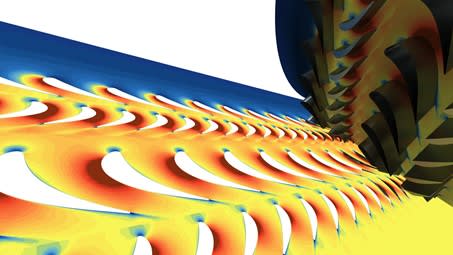
Circumferential averaging of the axial velocity field in a gas turbine. An important data analysis tool for better engineering decisions across blade designs is the new blade-to-blade view in the 2021 version of Simcenter STAR-CCM+. With Section Flattening, you can now project a complex 3D blade-to-blade solution to a flattened 2D view. This helps to understand performance, visualize flow behavior and ensures consistent comparisons between designs.
Deeper Functional Insights
As for Simcenter STAR-CCM+, a new version launched in the middle of 2021. The important point here is that the solution has gained Amazon Web Services (AWS) High Performance Computing (HPC) competence status. Simply put, this means that the solution can optimize its HPC workloads for performance and efficiency using AWS cloud infrastructure.
But there are additional interesting improvements in the new version of this multiphysics and CFD software. Among other things, it contains new functions for sharpening the modeling of today’s increasingly complex products. “A consequence of this is that product developers can broaden their exploration of design possibilities and that the increase in performance that comes with the new version means that all this can be done faster,” Siemens concluded in the press material around the new version.
Another improvement is that Simcenter STAR-CCM+ “can better model the complexity of today’s products through electromagnetic simulations.”
“For all applications with electrical circuits, including electrical machines, switches and batteries, engineers can now save significant time with the new Electric Circuit Editor,” said Daryl Snider, VP for Computational Continuum Mechanics team at Siemens Digital Industries Software.
According to this reasoning, engineers can sketch sophisticated circuits with an easy-to-use and intuitive graphical interface, which improves the usability of the circuit model and saves valuable development time.
Siemens further states that the version expands the coverage for electromagnetic applications for electrical machines with the introduction of a new excitation coil model, which enables the design of machines with higher power density with closed coils, such as those found in machines with axial flow.
“Simcenter STAR-CCM+ continues to expand its capabilities to model the complexity of today’s products through integrated multiphysics CFD simulations,” sums up Snyder. “These improvements enable users to take advantage of this increasing complexity as a competitive advantage to design more innovative.”

